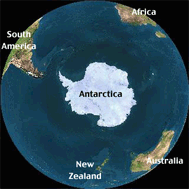
![]()
|
|
 From the National Science Foundation, Office of Polar Programs
|
Antarctica is a place like no other. Ice and snow cover 98% of the continent while high mountain peaks and a few other bare rocky areas make up the only visible land. It is a region of extremes: the coldest, windiest, driest, and highest of all the continents. Stormy waters of the Atlantic, Indian, and Pacific oceans surround Antarctica keeping it isolated and alone at the bottom of the world.
 |
Only a few small plants and insects can survive on this harsh and rugged continent but many animals thrive in the surrounding waters. Fish, krill, penguins, seals, whales, and many kinds of sea birds call Antarctica their home, however, the freezing temperatures and months of darkness make life for its few inhabitants an eternal battle for survival.
For centuries, Antarctica has been a destination for exploration and discovery but our scientific knowledge of the continent stems from the research carried out during the International Geophysical Year (IGY) in 1957-58. During the IGY, scientists from around the world established stations across the continent and surrounding islands to study earthquakes, gravity, magnetism, oceans, and solar activity. The first complete weather charts for Antarctica were completed during the IGY while other scientists measured the thickness of the ice cap and studied the shape of the land. The cooperation and goodwill throughout the IGY led to the negotiation of a treaty to protect Antarctica.
In 1961, the Antarctic
Treaty took effect with signatures from the twelve countries who
participated in the IGY. The treaty is a surprisingly short and
simple document, but it is one of the most successful international
agreements ever made. It deals with issues regarding the future of
Antarctica and recognizes that:

The Antarctic Treaty guarantees four things:
- Antarctica will remain open for scientific research to nations who agree to the treaty.
- No military bases can be built on the continent.
- There will be no testing of nuclear weapons or dumping of nuclear waste in Antarctica.
- No claims of ownership are recognized or denied, and no new claims of ownership can be made.
Since the treaty took effect several additional countries have signed on and members have added laws to protect Antarctic plants and animals. In 1991, the treaty was further strengthened by the Protocol on Environmental Protection which defines Antarctica as a "natural reserve devoted to peace and science." Today, scientists maintain year-round research stations throughout Antarctica but it remains an untamed wilderness.
![]()
